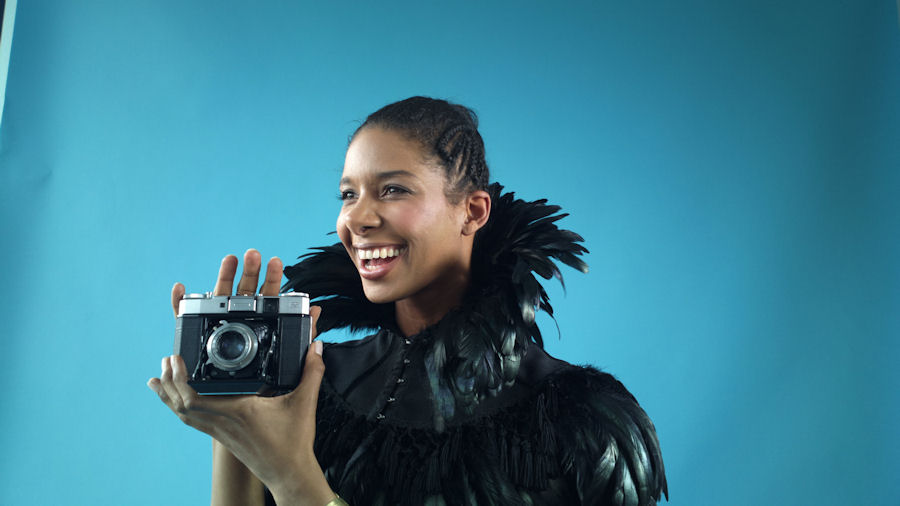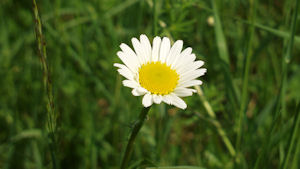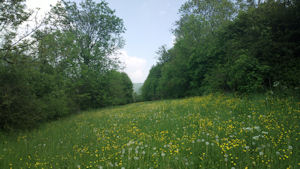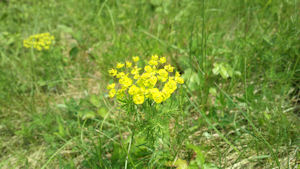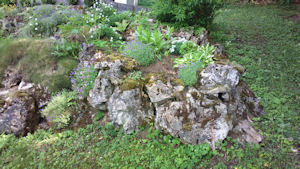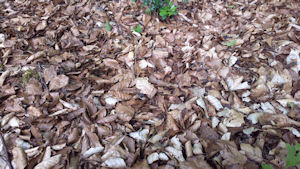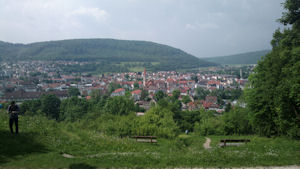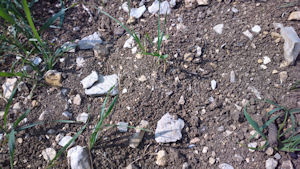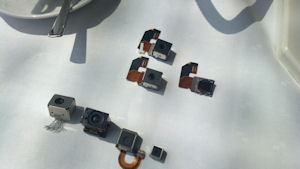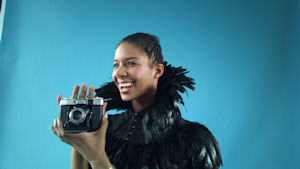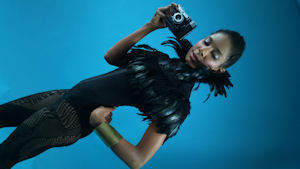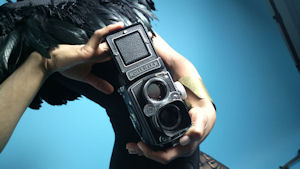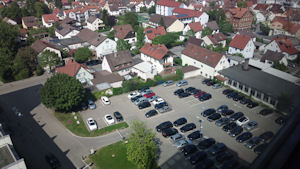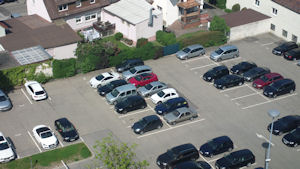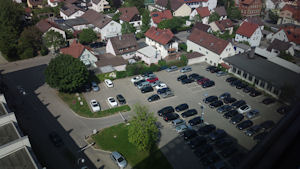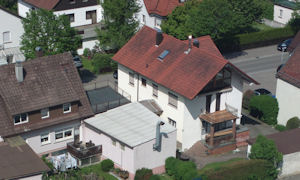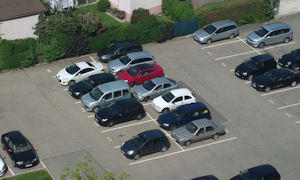
Sample image from a Nokia 808 PureView
The last Symbian flagship?
While all the attention is, rightly, on the Nokia 808's camera, for some an important reason to buy the device will be its status as a Symbian flagship device. This is All About Symbian, so let's look at this dimension briefly, before moving on to the siren call of the camera.
Not only is the 808 a Symbian flagship, it is, in the lights of Nokia's February 2011 platform shift to Windows Phone, almost certainly the last Symbian flagship. For some this means it will be a must have device; in part that's because it delays any platform switch decision by anything up to a couple of years, but also because it represents the pinnacle of the platform that created the smartphone.
Outside of the camera, there's a rich set of hardware functionality: four inch AMOLED screen, through the 16GB of mass memory (plus microSD card slot), 1400 mAh removable battery, HDMI out, sensors (GPS, accelerometer, ambient light, proximity), FM receiver and transmitter, and comprehensive connectivity (NFC, Bluetooth, microUSB, pentaband 3G, WiFi). This reflects the maturity of the Symbian platform and it's notable, even leaving aside the camera, that in terms of hardware features, both Nokia's Windows Phone devices and other competing smartphones have yet to match the full spectrum of functionality.
The Nokia 808 runs Nokia Belle Feature Pack 1, previously known as Symbian Carla, which offers a feature rich and mature smartphone experience. Compared to Nokia Belle, Feature Pack 1 adds a number of new widgets and homescreen enhancements, introduces Dolby Headphone functionality, updates the Web browser to version 8.2 (improved HTML 5 support and performance), and significantly improves overall performance. For users of the first generation of Symbian^3 devices, like the Nokia N8, the biggest improvement is the speed - Symbian has never been so fast.
Those familiar with Symbian will find the 808 continues the very best traditions of the platform - outstanding power and resource management, unheralded feature depth and a phone-first philosophy. What's more, those returning to Symbian, because they want the 808's camera, may be pleasantly surprised by just how much it has improved in the past year. The advent, in the last year, of the Anna, Belle software updates and associated app and service upgrades mean that Symbian has seen more changes and improvements that any other mobile platform. As a result, the platform is much closer to its competitors than many people assume.
A camera centric design
A quick glance at the Nokia 808 immediately reveals it as a camera-centric device, thanks to the hump surrounding the camera module. In images, this hump makes the device seem rather bulky, but in reality it's less noticeable that you might think. It's probably fair to say the 808 would not win a beauty contest against a sleek device like the Nokia N9 or Nokia Lumia 800, but, with echoes of the Nokia C7 design language, it does have a beauty of its own and it is hard to see how the design could be improved without sacrificing the camera.
Build quality is excellent; the 808 feels as sturdy as any unibody design, but maintains the advantage of having a removable battery. Materials are top notch too: The majority of the casing is made from a high quality polycarbonate, with a grippy ceramic-like finish; the surrounding buttons and controls are made from stainless steel; and both the four inch screen and camera module are protected by Gorilla Glass.
More generally, various design cues, such as the fit-in-the-hand comfort (rounded edges and weighting) and the positioning of the camera shutter, gives a sense of a camera-centric design. It's hard to pin down exactly, but it almost feels as if the 808 is a compact camera hiding in the remnant clothes of a smartphone.
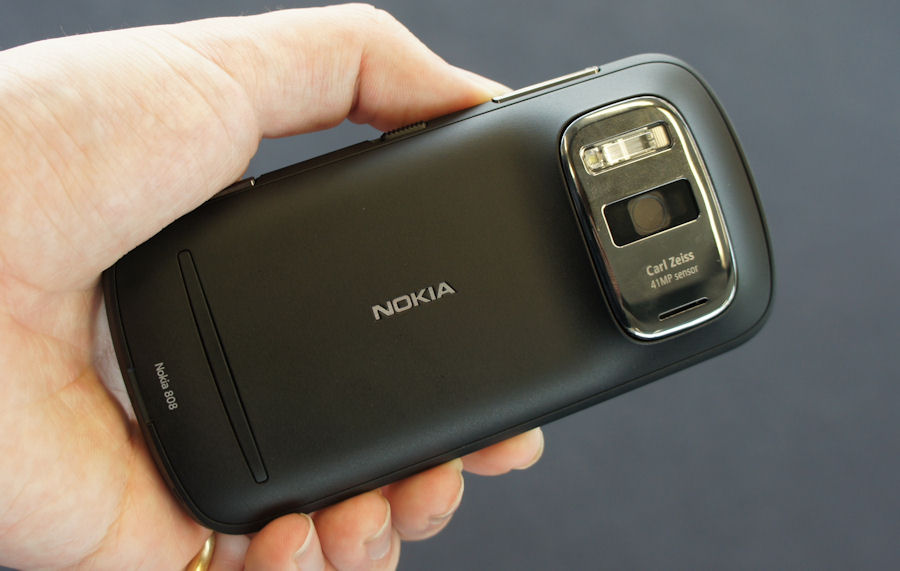
This feeling of camera centricity is reinforced by the UI of the 808's camera app, which has been built using Qt and QML. It has been optimised for use whilst holding the device in camera shooting mode: landscape orientation; with right finger curled around the bottom of the device; forefinger on the shutter button; and thumb, moveable in a 90 degree arc, for touchscreen interaction. All the key controls and settings can be reached and adjusted using only your thumb.
While some of the design cues and iconography in the camera UI are familiar from Nokia's Symbian, MeeGo and Windows Phone devices, the UI layout and approach has been reworked. It's now more consistent, intuitive and easier to use. There are plenty of clever touches such as the zoom control, which works by sliding your thumb up and down the screen, and the "as-live" settings controls (e.g. move the saturation slider and the on-screen view changes to match the setting).
However, the biggest overall impact comes from the camera app's three modes (automatic, scenes, and creative), which effectively means you have three camera apps in one, each of which is optimised around a different type of user. The different modes are accessed using an omnipresent toggle at the top of the screen.
Automatic mode, which is the default mode, is the simplest of the three and minimises the number of controls (flash control, shutter button, toggle switch for video/stills, and shortcut to Gallery) in order to keep things as simple as possible.
Scenes mode adds an extra level of complexity, allowing the user to provide additional guidance by specifying a scene type: landscape, automatic, close-up, portrait, sports, night, night portrait, spotlight and snow. The last two of these are new, with 'spotlight' optimised for shooting in concert conditions (bright side lighting) and 'snow' optimised for use in Finland in the winter(!)
Creative mode offers full control over a wide range of settings including exposure control (with on-screen histogram), white balance, ISO controls, neutral density filter control (with impact on shutter speed), focus mode (infinity, hyperfocal, close-up, automatic), colour tones, capture modes (bracketing, interval, self-timer), saturation, contrast, and sharpness. Creative mode also lets you choose between full resolution mode (38/34MP) and three levels of PureView mode (8MP, 5MP, 2MP). Three pre-sets (C1, C2 and C3) let you store different combination of settings, enabling you to jump into a specific usage scenario quickly.
For video capture, the camera app has the same three modes, with video-specific options such as resolution and frame rate replacing some of the still image specific settings.
Across all three modes, the controls that you need to access most often are placed on the right hand side of screen (closest to your thumb), with secondary level controls on the left and, for creative mode, tertiary levels controls accessed via the mode toggle at the top of the screen.
Those familiar with Nokia's Symbian camera UI, which has improved only very slowly over the years, will find the 808 a revelation. It is immediately obvious that a great deal of time and effort has gone into creating the improved UI. It's great to see a Nokia device with a UI worthy of the underlying sensor, optics and software.
PureView
The key selling point of the Nokia 808 PureView is of course the camera. Before using some image samples to look at this in greater detail, it is worth reminding ourselves that PureView is a handy brand name for a collection of technologies, which can be summarised into three key areas:
The first part of PureView is a high quality sensor. In the case of the 808, it is a 1/1.2" sensor with a 41MP resolution. It's not an off-the-shelf component, but rather something that Nokia, together with its partners, has designed themselves. Much of the technology within it is proprietary to Nokia and that means it is not going to be possible for another manufacturer to come along and use the same sensor. Instead they'll have to do their own research and development.
The second part of PureView is high quality optics. For this, Nokia sign an exclusive partnership with Carl Zeiss, with whom the lenses are developed collaboratively. The 808's lens is of exceptionally high quality, indeed, in terms of optical performance, it is significantly better than the lenses found in typical mid range DSLRs. That's a necessary attribute because its smaller relative size means any imperfections have a greater impact.
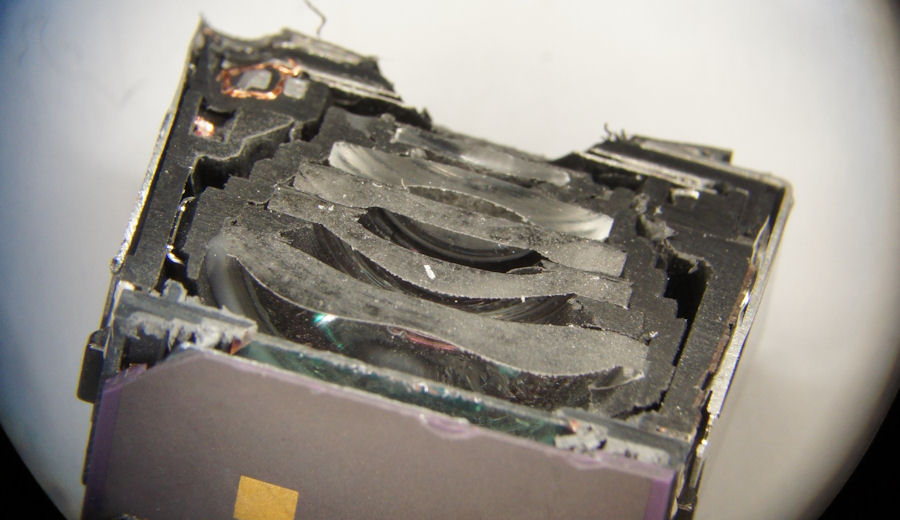
This photograph shows a cut-through / cross-section of the Nokia 808's PureView camera module under a microscope. The top of the image is the front of the module, with the sensor, at the back of the module, sitting at the bottom of the image. The lens is made up of five elements, with the back element having the dimple and extreme asphericity that is a hallmark of higher quality cameraphone lenses.
The third part of PureView is software processing. The sensor and optics dictate the bounds of the collected raw data, but how effectively that data is used is almost entirely down to software. It's not a simple case of one size fits all. The processing applied is dictated by the context in which the photo is taken. In fully automatic mode it is entirely down to the camera software, in scene and creative modes you can influence the process by applying settings, but the major proportion is still dictated by the quality of processing algorithms. This processing is aided by a dedicated imaging processor, capable of handling up to a billion pixels per second (1080p video). The dedicated processor also means the 808 is very fast when browsing, zooming in on, and editing, images stored on the phone.
Something that Nokia has made clear from the start is that PureView will be used in "multiple future products". While Nokia never talks about the specifics of a future products, it is clear that the intention is to move PureView to the Windows Phone Lumia range. The likelihood is that the sensor size and megapixel count will come down in order to meet the constraints of a thinner device design (i.e. less of a camera hump). That does mean that the 808 PureView is likely to remain the ultimate cameraphone device for some time to come.
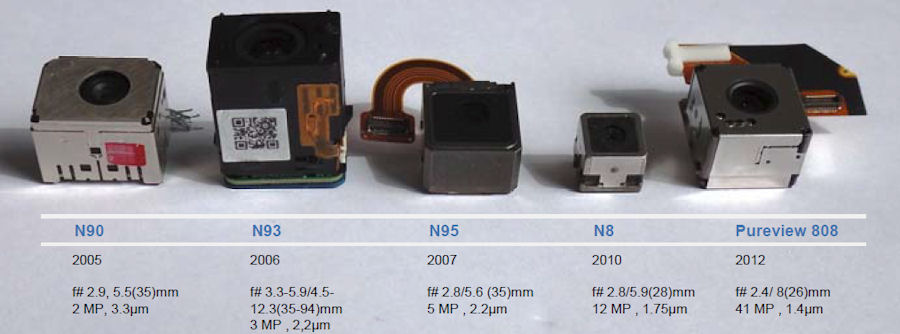
Nokia camera modules down the years, with date, f-stop, megapixel count and pixel size information below. Note the gradually decreasing size from N90 to the N8 as a result of production and design improvements. The Nokia 808 PureView bucks this trend because of the increased sensor size and associated optics, with the size increase emblematic of the revolutionary, rather than evolutionary leap it represents. The PureView 808 module is about 75% the size of a penny; by comparison most current cameraphone module are smaller than a pin head.
Sample Images
All the sample image below are also available in this Flickr set.
Below are a variety of sample images captured using the 808's PureView mode at 5MP and 16:9 aspect ratio (3071 x 1728). This is the default setting of the camera and is the way it's most likely to be used day to day. Using the camera app's creative mode, it is also possible to use PureView mode at 8MP and 2MP.
The magic of PureView mode is that an oversampling technique is used, with multiple pixels from the sensor being combined to create one perfect pixel in the captured image. At 5MP, roughly seven pixels from the sensor are combined to create one "superpixel" in the captured image. By combining the data from multiple pixels together, digital noise is greatly reduced because any imperfections are aggregated out. In addition, colour representation is more accurate because there will always be at least one red, green and blue pixel within each superpixel - in particular blocks of colour - such as a blue sky - are captured with more accuracy.
Incidentally, the knock on effect of these two factors is reduced file size - that's because the JPEG compression algorithms operate more efficiently when there are fewer artefacts in an image.
More importantly, it means a 5MP image from a Nokia 808 PureView looks much better than a 5MP image from a cameraphone or a compact camera. The clear visual difference was a surprise for me - I didn't think a 5MP image could be that good. In assessing the 808, it's necessary to re-adjust your expectations of what's possible from a compact camera. To see this full impact you really do need to look at high quality prints - looking at A3 prints the impact is startling - and the 808's 5MP output will work well at any size up to 50 x 70 cm. If you're just looking at the images on screen then the chances are the properties of the screen technology will have more of an impact on your perception of the image than the underlying image quality itself.
Below are two sample images demonstrating the 808's lossless zoom. Both images are 5MP (3071 x 1728). In the first, PureView's oversampling technique is used, with the seven to one pixel ratio. In the second, at 3x zoom, this pixel ratio is one to one, which means a true 5 megapixel image is being captured. At full zoom this does mean the benefits of the superpixel are sacrificed, but that's a very minor issue compared to the digital zoom techniques typically used in cameraphones.
Moreover this zoom technique also means the aperture setting (f/2.4) is the same as the first image. Typically compact cameras use variable aperture zoom lenses (i.e. the aperture number goes up when you zoom). A lower aperture number is generally better as it means more light is hitting the sensor, allowing for more accurate image capture. The 808 also avoids the distortion issue typically found in optical zooms, plus because there's nothing moving it's completely silent, which is vital when shooting video.
The lossless zoom is the most impressive demonstration of the benefits of including a large megapixel count in the 808 PureView, although, ultimately, the oversampling/super pixel technique is more important, given its more common use case and impact on overall image quality.
The four sample images below were taken in full resolution mode. Full resolution, which captures images at 38MP (7152 x 5368) for 4:3 aspect ratio mode, or 34MP (7728 x 4354) for 16:9 aspect ratio mode. That's less than the sensor's full size of 41MP because the corners of the sensor fall outside the optical format area for both aspect ratios. Full resolution images are captured using the camera app's creative mode.
Full resolution mode produces file sizes of between 6MB and 14MB, which means it's not really practical for day to day use. It also does away with the superpixel technqiue, removing a significant benefit of the software portion of the PureView trifecta. As such, full resolution mode might best be seen as a separate, bonus camera experience that you happen to get in addition to the PureView main event.
Note the full size images (click through to access) are each around 10MB in size.
One of the advantages of using the full resolution mode is that you can crop from within a photo, but still retain a reasonable resolution. This effectively allows you to create photos from within a photo, as demonstrated below (both "extracted" photos from fourth sample above). The 808's built in image editor includes a cropping tools that makes it very easy to create these new images directly on the phone.
These samples offer a limited showcase of the 808's still image capture capabilities - they only really touch the surface. The 808 also supports video capture at 1080p (full HD) at 30 frames per second, with up to 4x lossless zoom. The Carl Zeiss event concentrated on the 808's still imaging performance and Nokia asked us not to share video samples. However, based on some of the samples we did see, video capture looks very promising.
We'll cover both the still imaging and video capture capabilities of the Nokia 808 PureView in much greater detail, in a whole range of capture scenarios, once we have hands-on with review (retail) devices.
Summary
So how close does the Nokia 808 PureView feel to being ready? Very close is the answer - in the few hours I had with the 808, it felt and operated like a finished product. Fine tuning of image and video capture performance is ongoing and will continue even once the device hits the shops, but, according to Nokia, it is now just a few weeks away from shipping to consumers.
Nokia has officially announced that Russia and India will be amongst the first markets to get the device, but Nokia representatives made it clear it will be widely available. How many operators will choose to range it remains uncertain; it's obvious that the 808 is something of a specialist device. This means that while the 808 will be available SIM-free in almost all markets, it may not be available with an operator subsidy.
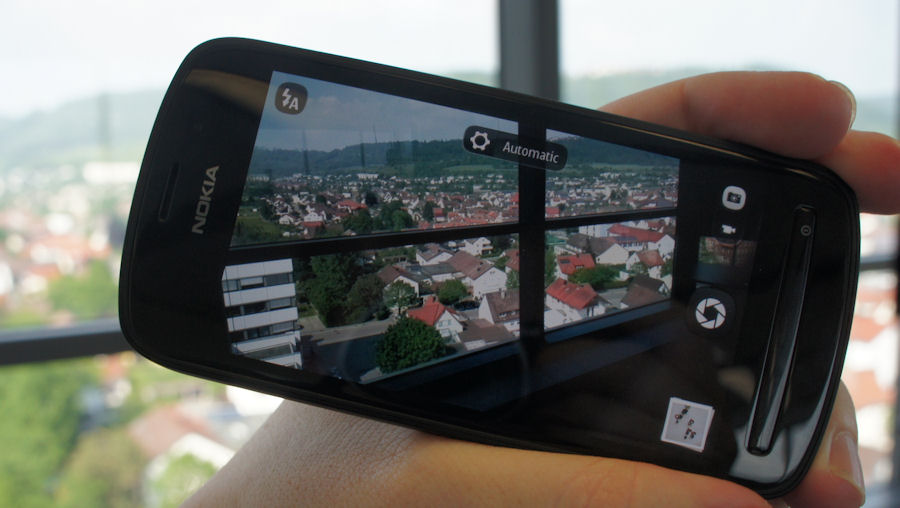
Clearly, it will be necessary to spend more time with the device before forming any final conclusion. We'll be publishing detailed review coverage once units are available. But, even after using the Nokia 808 PureView for a few hours, it's hard not to get excited. It really is an amazing imaging device - there's a lot of hype around, but the truth is that it appears to be almost entirely justified.
Nokia has made some impressive imaging advances over the years with devices like the Nokia N90, N93, N82, N86 and N8, but the 808 stands out even from this select company. Yes, the Nokia 808 PureView sets a new benchmark for cameraphones. But the real eye opener is that it looks like Nokia has made what is arguably also the best compact camera on the planet.
See Also
Top 10 Nokia 808 PureView questions and answers
The Nokia 808 PureView and Dynamic range
Nokia Rich Recording demonstrated
Video: Making the Nokia 808 PureView


